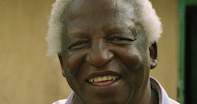
A Life’s Work
Dr Peter Magubane's lounge is filled with bright-beaded pots and wooden carvings. In the corner an antique gramophone sits proudly near a black and white photograph of him masquerading a trumpet.
From behind a straw hat, a beaming young Sophiatown gent strikes a pose. As he sits in front of a window, light illuminates Dr Magubane's trademark white hair. The image we are left with is of a man whose life's work is inseparable from the weave of more than half a century of South Africa's history.
From Driver to Photojournalist
Sophiatown, 1955. It's a Saturday night. The swanky gents and classy dames are out on the town, dressed to the nines. High heels rat-a-tat-tat on the dusty streets. The seductive jazz draws you into a nearby shebeen. Inside foot-tapping saxophones and social debates fill the air.
In the corner a handsome, 23-year-old Peter discusses newsbeats with his Drum friends, Can Themba 'the English master' and Bob Gosani 'the brilliant photographer'. In less than a year Peter has worked his way up the magazine's ranks from driver to photojournalist. These three are some of the many stars that Sophiatown has raised.
While others have chosen the political platform to confront the social injustices of apartheid, Peter has chosen the camera. He reveals, 'I wanted to document the lives of black South Africans at the time. That was what drove me to photography.' The Peter back in 1955 has no idea what the years ahead have in store for him. Sophiatown, present day.
As Peter drives through Sophiatown en route to Soweto, he recalls his childhood spent on her streets. The old mining-town-style houses, built on the ruins of Sophiatown for the white suburb of Triomf ('Triumph'), stand on soil that is historically loaded. It's hard to imagine the legendary days of the Sophiatown that gave birth to activists and artists such as Peter.
Those streets own his boyhood memories: the first camera his father gave to him, his mother's love and discipline, the matchbox home his family filled, being stabbed one day while out playing.
 Soweto developed at the same time as Johannesburg, and for the same reason - gold. In 1885, the gold rush was in full swing, prospectors fro...
Soweto developed at the same time as Johannesburg, and for the same reason - gold. In 1885, the gold rush was in full swing, prospectors fro... 'Township Music' probably started as a crossover between gospel choirs and black minstrel shows that developed as early as the 1920’s....
'Township Music' probably started as a crossover between gospel choirs and black minstrel shows that developed as early as the 1920’s....